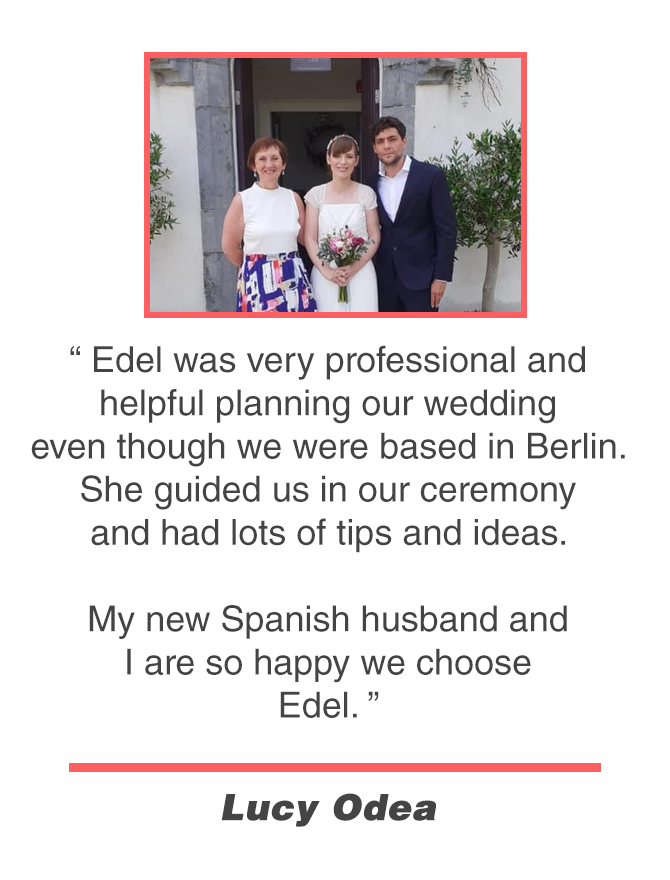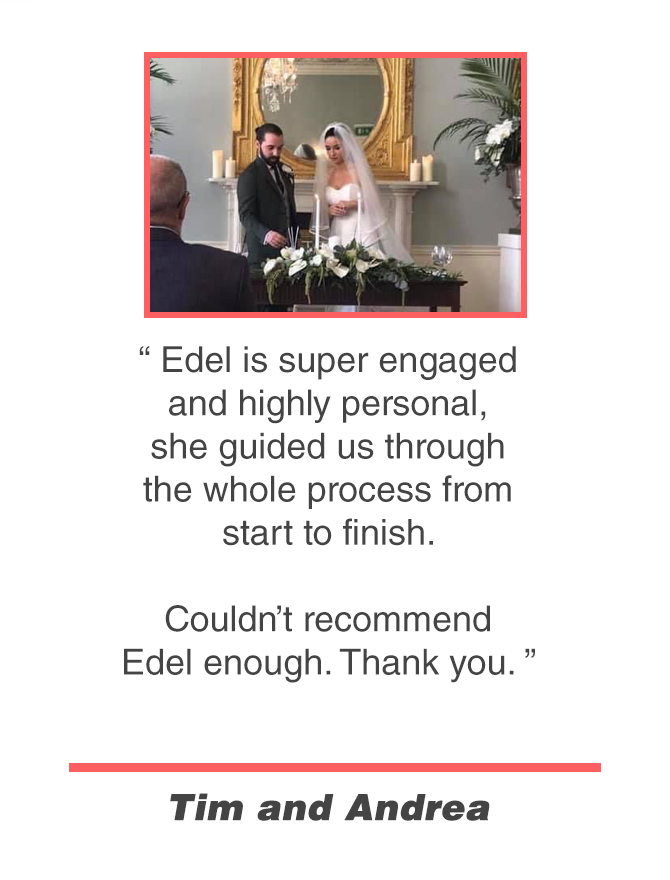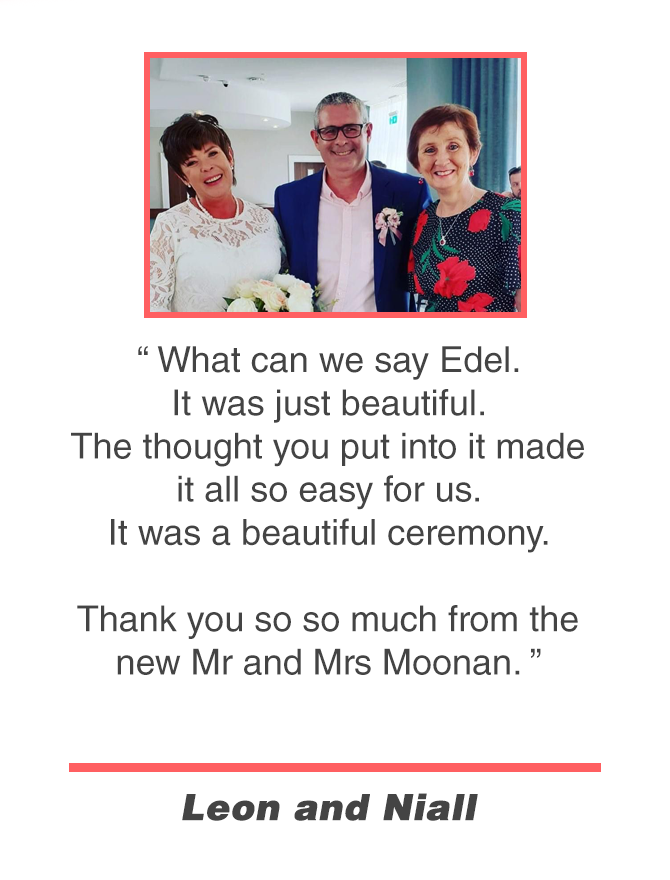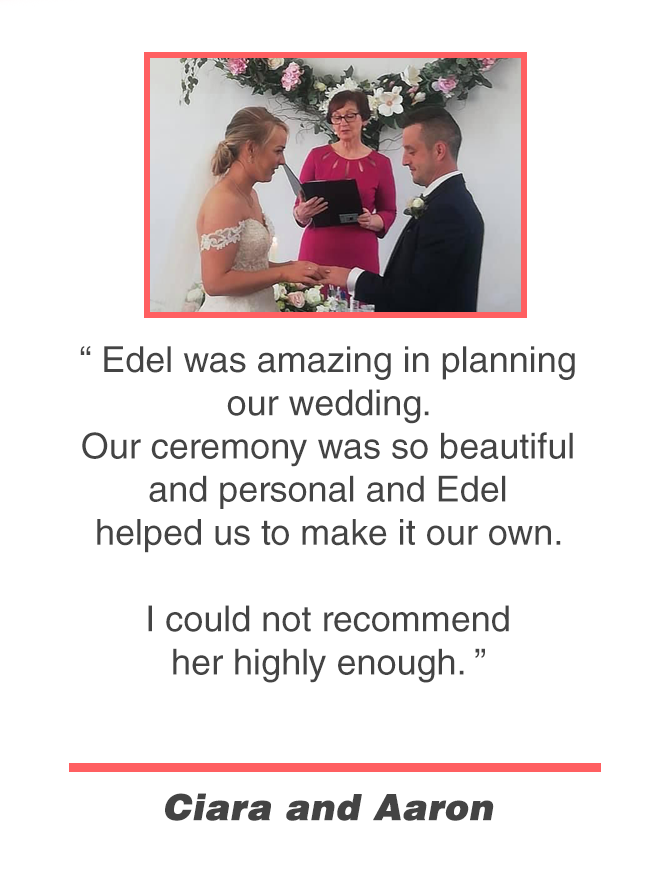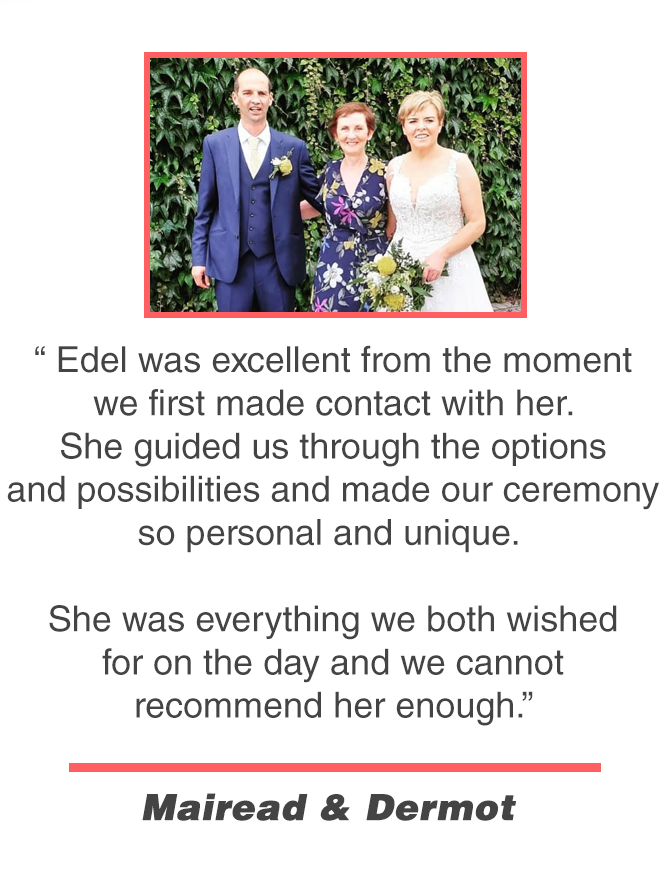

Frequently Asked Questions
Can Rev Edel O’Connell perform the legal aspect of our marriage ?YES! I am a HSE Registered Solemniser, and can Legally Solemnise your marriage at your venue on your chosen day.
What’s particularly wonderful about an Interfaith ceremony is that we offer you complete freedom and flexibility in choosing your content .Each ceremony is a personal reflection of who you are as a couple and where you are heading together.
I will work with you to create your own vows and to design a meaningful ceremony which can include your favourite readings and music.
Are you a Humanist / Spiritualist ?
I am a One World Interfaith Minister, which gives me the freedom to perform ceremonies for people of all faiths and/or none.
I have no agenda with regard to your ceremony, it can be spiritual or secular, you choose, using whatever language, music and readings you choose.
I also have no requirement to speak about any parent organisation during your ceremony.
I have taken a vow of inclusivity and I welcome diversity of gender, orientation, colour, nationality, ability, culture or any other reason- within the bounds of Irish law.
Because I am authorised to carry out ceremonies for couples of all faiths and none,
I have been listed on the HSE Register of Solemnisers as a religious Solemniser, as opposed to secular.
This sometimes causes confusion for couples who want a secular/atheist/humanist ceremony. This classification has absolutely no bearing on the content of your ceremony.
Can you Solemnise our marriage on a Saturday / Sunday / Bank Holiday ?
Yes! I can Legally Solemnise your marriage at any time, on any day of the week, in any venue approved by the HSE, that is compliant with Section 52 of the Civil Registrations Act 2004.
The main requirements being that the Solemnisation takes place at an identifiable address which is open to the general public.
Ceremonies with no Legal component can take place at any Venue.
How do we Register our marriage ?
You must visit a HSE Registrar to register your Intent to Marry, NO LESS THAN THREE MONTHS prior to your intended wedding date.
The HSE will then give you your Marriage Registration Form (MRF) usually in a green folder, which you will bring with you on your wedding day.
Full details are available from the H.S.E. WEBSITE
How long will the ceremony last ?
Most ceremonies last around 25-35 minutes, depending on your music choices, ceremony enhancements, photographs etc.
How do we obtain our Marriage Certificate ?
You retain the paperwork (in the green folder) after it is signed on the
day of your ceremony. (You should nominate someone to ensure it is
put away safely, immediately after the ceremony)!
You then return the MFR (Marriage Registration Form) within one
month to the HSE Registrar, for the marriage to be registered and
your civil marriage certificate will be issued to you.
Full details are available from the H.S.E. WEBSITE
How much will it cost?
CONTACT ME to discuss fees for creating your bespoke ceremony and supporting you in the lead-up to your ceremony.
Your Questions Answered

“With a Celebrant-led ceremony you get to choose what you want to include and what you don’t want included.
The ceremony can be as elaborate and simple as you like, but most of all it always reflects you and you both as a couple. If you are set on a wedding with only a few guests, and want the ceremony to be around half an hour/forty minutes with very little ‘ceremony’, then a Celebrant-led one is for you.
Many couples are looking for something very understated, with the stuffiness of a church wedding taken out. A Celebrant-led ceremony is the perfect solution.”
Do we have to write our own vows?
Writing your own vows is a personal choice and there is no hard and fast rule that says you have to do it!
“It’s perfectly acceptable to use traditional wedding vows if you feel more comfortable with that option. It is true to say that writing your own vows can be a beautiful way to express your love and commitment to your partner in a unique and personal manner, however it will not detract from your ceremony in the slightest if you choose from traditional vows which can be personalised and delivered by your celebrant.”
Many couples feel shy or nervous about writing their own vows. If this is you, here are some suggestions:
Discuss it with your partner:
Talk openly with your partner about your concerns and feelings of shyness. They may have similar feelings or be willing to help you through the process.
Take it step by step:
Start by jotting down a few thoughts or phrases that come to mind when you think about your partner and your relationship. Focus on the qualities you love about them or memorable moments you’ve shared. Gradually expand on these ideas until you have a complete set of vows.
Seek inspiration:
Read examples of wedding vows online or in books to get inspiration. Your celebrant can provide various templates and prompts to help you structure your vows and find the right words.
Practice & rehearse:
Once you have written your vows, practice reading them aloud. This will help you become more familiar and comfortable with the words. You can also rehearse in front of a mirror or with a close friend or family member for added support.
Keep it simple:
Remember that your vows don’t have to be long or overly elaborate. The most important thing is that they come from the heart and reflect your genuine feelings. Focus on sincerity rather than worrying about being too extravagant or eloquent.
Consider alternatives:
If you’re still uncomfortable with writing your own vows, there are other ways to personalise your wedding ceremony.

You get to choose the details! “From your choice of readings, to your personal vows, ring exchange, wording and when it comes to Enhancements or mini ceremonies such as Handfasting, Unity Candles, Quaich Ceremony to name just a few, then the sky’s the limit.”
“Another way to personalise your ceremony is the “Couples Story”. As part of the samples I send to each couple, are your questionnaires. These give me an insight into you how you met, your journey’s ups and downs, funny incidents, what you love about each other and even how he or she sometimes drives you mad.
Based on your answers, your story becomes a very personal and fun part of the ceremony as a whole. It gives your guests a snap shot of who you are, why you want to spend the rest of your lives together and of course what marriage means for you. It’s a chance to have great fun and the result is always laughter and love. Word of warning I always say to couples is, be careful what you write…make sure you don’t write anything you wouldn’t want me to say on the day! We don’t want any blushes or rows going down the aisle!”
How can we include our children in the ceremony?
Have them come in before the bride throwing down petals in the path, from a basket.
Have one of them bring up the rings as part of the bridal procession then come forward with the rings jusy before the exchange and hiold them out while I bless them.
Do a reading – I have lots of readings suitable for children including a lovely Winnie the Pooh one.
Involve them in the handfasting by reading out one of the qualities of the marriage when I tie the knot after wrapping (3 times).
Take part in the Sand Ceremony – the bride and groom and each of the children have some coloured sand in small glass containers. The bride and groom put half of their sand into a larger container showing that they are the rock of the family.
Then each child puts their coloured sand into the larger container and finally the bride and groom empty the rest of their sand on top demonstrating that they surround their children with unconditional love. The different coloured sands shows the uniqueness and diversity of each individual yet together it makes a harmonious, colourful unit.
Have the children stand next to you when you make your vows.
Demonstrate the symbolism of the family coming together:
Handfasting:
Another way to include children in the ceremony is for them to present the ribbons for the handfasting. The handfasting ceremony can be tailored to include the children. For example, Dhá Chroi (two hearts) can be Trí Chroi (three hearts) or Ceithre Chroi (four hearts).
A puzzle:
You could include children by creating a puzzle bearing all of the families names. This is a lovely way for children from previous unions to become part of this new union.
Fingerprint tree:
Another idea that I have used is during the ceremony creating a fingerprint tree with paints on a pre-drawn tree. The symbolism demonstrates the commitment of the family towards the new blended family.

How can we include guests in our wedding ceremony?
“Go with your gut when trying to decide on every aspect of your wedding, if something feels silly or irrelevant to you then you’re not going to ‘get it’ in your ceremony/day.” If you do want to include all your guests in your ceremony, why not try one of Trisha’s most popular enhancements, the Oathing Stone ritual?
“I make these and personalise them for my couples to be used at their vows but also to include their guests in the ceremony. They are handed around at the beginning of the ceremony (like blessing/warming of the rings) for each person to hold/wish/imbue them with their love and intentions for the couple before the couple say their vows on it. It is both a physical ‘touch stone’ and a symbolic one for their guests and helps to draw everyone into the ceremony. It is also then a lovely keepsake for the couple.”
Involving your Parents in the ceremony
Lots of people are terrified of speaking in front of others, but she also has some fabulous ideas for ways you can involve people without them having to speak:
“One of my favourites is to involve a guest in the ring warming ceremony. Your Mum could hold the rings and then, when I announce commencement of ring warming, I can say that she will make the first wish for you two as a couple and then start the rings on their journey around the guests. So all she has to do is hold the rings, make a wish for you and pass them to the person beside her. Simple! But very meaningful also.
If she is a little more brave, she might like to come up to light one or the two initial candles to represent you two as individuals and also your two families. This is a lovely symbolic ritual but, once again, she won’t have to speak, so not too much pressure. It also has the advantage of happening early in the ceremony so she gets it over with at the beginning and can then relax and enjoy the rest of the ceremony.”
Do we need to do a rehearsal?
“I will guide you through your entire ceremony, it is my aim that all you need to do is show up , relax and enjoy your ceremony, that you live every moment of it. I am there beforehand to meet with readers and guests to put them at ease and talk them through their involvement in the ceremony and to speak with musicians. Of course, if a rehearsal is something a couple wants to do and it is feasible, yes! We can do it, but it is not a necessity.”

Asking couples how they’re feeling about the wedding, they often reply “I will relax after the ceremony”. But how about actually enjoying the ceremony?
Lots of people are terrified of speaking in front of others, but she also has some fabulous ideas for ways you can involve people without them having to speak:
“The wedding ceremony is a culmination of many hours of planning, negotiation, coordination and meeting of family members and friends. Each one of these items, by itself is enough to send any of us in panic. And there are people that make it look very easy. You can reduce the levels of stress you are experiencing, and the sooner you start the better. I will use this analogy: Think of your teeth: you don’t brush them once in your life and expect that it will be enough for them to be well for the rest of your life. But if you brush them twice a day, every day, you are taking care of them and reduce the chances of any issues. Same with your self-care practice: 1 meditation in your life will not make much difference in your overall wellbeing. But if you add a short practice twice a day, every day, that will make a huge difference to your wellbeing. And just like teeth, you might miss a day here and there, but that will be ok, if you maintain the practice the majority of the time.”
“As you practice to relax every day starting today, you are expanding your capacity to handle stressful situation such as your wedding ceremony. The practice will look different to each of us. Some ideas are walking, running, yoga, meditation, breathing exercise, swimming, signing, gardening, reading a book. Not all of them together! Just pick one! Start today! Working with a professional wedding celebrant who will take care of all the details for your wedding ceremony will also help reduce the stress.”

“Once you have your date agreed and your venue and Solemniser booked, you can arrange for the HSE process to begin. Depending on the couple’s individual circumstances, (ie, if they are native Irish, or coming from abroad) the required documents might vary that are required.
So simply contact the most convenient HSE office for you and they will help you with advice of what to do and what documents they will require (If you are abroad, it can be possible to start the process online before your in-person meeting).
The sooner you start this process the better as it can be difficult to make contact with the HSE and set up your meeting with them. I have had couples that have done this up to a year or more in advance of their wedding date.”
Getting an appointment with the Registration Office?
“You need to ring the Registration Office that you want to attend to make the appointment. Don’t wait for a vacancy to appear online. The online booking system does not work for all areas and your best bet is to pick up the phone and ring them.”
How do I ensure that the legalities are carried out correctly?
1. Ensure the Green Book details are correct such as Names, Date of the Ceremony, Dates of Births, Witness Names are correct and the Venue is correct.
2. Ensure the Green Book is with the Celebrant/Solemniser at least 15 minutes pre-ceremony.
3. When signing the forms, ensure that everyone signs on the correct line.
4. Ensure the signatures are in black ink as it doesn’t fade.
5. The names used when stating the vows must be the same as those on the license.
6. There should be no alcohol in the room.
7. Post the forms back to the HSE within 4 weeks with a postal order for €21.50 for the license.

This is actually called the “Capture of Data” form and that you have three options: Civil, Religious or Secular.
CIVIL
These are the HSE Registrars only. Yes, if you’re having a CIVIL CEREMONY – that means that you are having an HSE Registrar conduct your ceremony for you. The ceremony can either take place in the Registry office itself – or you can request if a Registrar is available to go to your specific wedding venue**.
Civil ceremonies take place Monday – Friday only. The ceremony itself cannot include any religious, spiritual/faith-based wording, rituals, songs (instrumental or lyrical), or items (candles with crosses etc..) Fridays are the busiest days, for obvious reasons – so checking for availability as early as possible is highly recommended.
The HSE Registrar will be assigned to you 3-4 weeks out from your wedding date.
SECULAR
There are two Secular bodies on the HSE list of Solemnisers – Dara Molloy (based on the Aran Islands) and the Humanist Association of Ireland.
Secular ceremonies can take place on any day – pending availability of the Solemniser, in a venue of your choosing**
Inclusions in the ceremony will be depending on organisation chosen.
RELIGIOUS
These are ALL other Solemnisers in the Republic. They include Multi-faith, Catholic, Muslim, Hindi, Unitarian, Spiritual, Pagan etc.
Religious ceremonies can usually take place on any day of the week.
These are the most common types of ceremonies in the country – as they cover so many varied faiths & beliefs. You can have your ceremony with little/no religious wording/content in your own venue** or one full of spirituality in a church/temple etc.. For Religious & Secular marriage ceremonies – you must find & book your own Solemniser prior to your Notification of Intent to Marry appointment with the HSE.
**Venues must be ‘open to the public’ for a legal marriage ceremony (ie; not private property/homes).
H.T. Weddings Online


